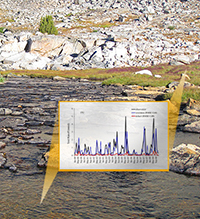Atmospher Sci & Global Chg
Research Highlights
February 2014
Adding Varoom to a Community Land Model
New study finds accurate parameters to rev up water and energy flux modeling

Water management decisions depend on precise information and finely honed predictions, especially in a world facing increased water impacts due to climate change. Scientists at PNNL are tackling these challenges through research to understand and portray how water moves through land systems under different environmental conditions. Enlarge Image. Photo courtesy of Dcrjsr, Creative Commons License.
Results: A high-performance engine requires constant work under the hood. Climate models are simulation machines with similar needs. Scientists at Pacific Northwest National Laboratory applied their sharpest calibration tools to improve water cycle representation in the Community Land Model. They developed a statistics-based approach to get the best estimates of climate model parameters. Applying this high-octane approach on water surface and runoff observations significantly improves simulating water and energy fluxes in the model under different climate and environmental conditions.
Why It Matters: Computational techniques are as critical to climate modeling as selecting the right tools to tune a Formula One racing car. As computational power increases, climate modeling researchers have developed tools to optimize and improve parameters—like the valves in an engine—in the models. The best model parameters yield model results that mimic actual climate observations. The tools generating those parameters help natural resource managers and policy makers to understand the implications of climate change. In this study, the researchers proved the viability of a statistical approach to improve model parameters. The new approach provides a better understanding of water and energy changes under a large group of climate conditions.
Methods: The research team, led by scientists at PNNL, developed an approach combining a stochastic inversion/calibration and Metropolis-Hasting sampling method that generates an effectively controlled series of random model parameter value choices until the optimal estimates are reached. The quality of these estimates depends on several factors that the researchers evaluated in this study, such as:
- How many observations are available
- How and where to pull initial guesses of model parameters
- How the observations are measured (day to day, or averaged monthly) to view the day-to-day variations or longer term averaged behavior
- How different the allowed new guesses are from the current guesses
- How the different kinds of observations are used for model improvement.
To increase computational efficiency, the team used PNNL's supercomputers to carry out the model calibrations along multiple lines simultaneously. Each chain consisted of a progression of initial guesses toward the true values of these model parameters.
Their analyses may be extended to a broader range of sites under different climate, hydrologic, and vegetation/soil conditions. The team's improved predictions coupled with the range of uncertainty for each will improve water management decision-making.
What's Next? Researchers will next tackle challenges of computational demand and the amount of observational data needed to improve regional and global climate models.
Acknowledgments
Sponsors: This research was supported by the Climate Science for a Sustainable Energy Future project, funded by the U.S. Department of Energy, Biological and Environmental Research program through the Earth System Modeling Program. Additional support for the model configuration and data sets used in the numerical experiments was provided by the PNNL Laboratory Directed Research and Development (LDRD) Program's PNNL Platform for Regional Integrated Modeling and Analysis (PRIMA) Initiative.
Research Team: Y. Sun, Zhangshuan (Jason) Hou, Maoyi Huang, and L. Ruby Leung, PNNL; F. Tian, Tsinghua University, Beijing, China.
Research Area: Climate & Earth Systems Science
Reference: Sun Y, Z Hou, M Huang, F Tian, and L Ruby Leung. 2013. "Inverse Modeling of Hydrologic Parameters using Surface Flux and Runoff Observations in the Community Land Model." Hydrology and Earth Systems Science (17)12:4995-5011. DOI: 10.5194/hess-17-4995-2013
